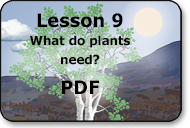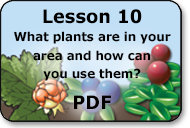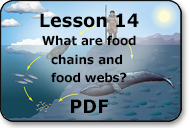What do plants need? |
In this lesson students will learn what a plant needs to grow. They will also build a model of a local plant.
Download PDF
On successful completion of this unit, students will be able to: identify air, water, light and nutrients, and room to grow as the things that a plant needs to grow; identify and describe local edible plants; and build a model of a local plant and describe the plant parts and how they help a plant to grow. |
 |
|
|
| Download PDF Lesson |
|
|
|
|
|
What plants are in your area and how can you use them? |
In this lesson, students will investigate local types of plants. Download PDF
On successful completion of this lesson, students will be able to:
Oobserve, identify, and describe local plants,classify local plants by their physical characteristics, and write a book about local berries. |
 |
|
|
| Download PDF Lesson |
|
|
|
|
|
What are some landforms? |
In this lesson, students will identify various landforms and water bodies in photographs of the Alaskan landscape, then demonstrate their understanding by identifying landforms in their own area and building models of those with clay.
Download PDF
On successful completion of this lesson, students will be able to: recognize and describe common landforms; and recognize and describe common bodies of water. |
 |
|
|
| Download PDF Lesson |
|
|
|
|
|
What changes Earth's surface?
|
|
In this lesson students will investigate how weathering (specifically water and wind) can slowly change Earth’s surface.
Download PDF
On successful completion of this lesson, students will be able to: name two different elements (wind, water) that help shape Earth’s surface; explain how water and wind can slowly change Earth’s surface; and retell stories (from a scientific and / or traditional knowledge perspective) about how land features came to be.
|
 |
|
|
|
Download PDF Lesson
|
| |
|
|
|
|
How do landforms change quickly and slowly? |
In this lesson, students model and record observations of different types of erosion (wave, water, and glacier). Students then apply their knowledge of erosion to identify examples around their community. Download PDF
On successful completion of this unit, students will be able to: identify three things that cause erosion (waves, water, glaciers); identify types of waves more likely to cause erosion; identify areas in their community where erosion is happening; and predict how erosion affects their community. |
|
|
|
| Download PDF |
|
|
|
|
|
What are food chains and food webs? |
In this lesson students will learn about the basic elements found in food chains and food webs. They will learn that animals and plants get their energy by consuming food, depend upon each other to survive, and that the food they eat can be traced back to living plants and plankton that produce food from the sun’s energy.
Download PDF
On successful completion of this lesson, students will be able to: identify the basic elements of a food chain and classify organisms into those elements; organize familiar plants and animals into a simple food chain; construct and describe a food web. |
 |
|
|
Downlad PDF Lesson |
|
|
|
|
|
What is life like in the ocean and on the tundra? |
In this lesson, students will learn about the characteristics of ocean and tundra ecosystems and how they are alike and different.
Download PDF
On successful completion of this lesson, students will be able to: given pictures or a list of animals, create a two circle Venn diagram and sort the animals and plants into the ocean or tundra ecosystem they live in; identify the conditions needed in the ocean and on the tundra for animals and plants to live; create food chains for the ocean and the tundra; draw and life in the ocean and the tundra and state how they are the same and different; use scientific processes and inquiry to directly support the concepts of the ecosystems.
|
|
|
|
|
|
|
|
|
|
What are some types of ecosystems? |
In this lesson, students will identify different types of ecosystems and their components, then use that knowledge to create their own ecosystem mobile.
Download PDF
On successful completion of this lesson, students will be able to: name at least two types of ecosystems found in their area; list component parts (living and non-living things) of at least one type of ecosystem in their area; name any plants or animals that are new or unusual in the ecosystem around their home.
|
|
|
|
|
|
|
|
|
|
|